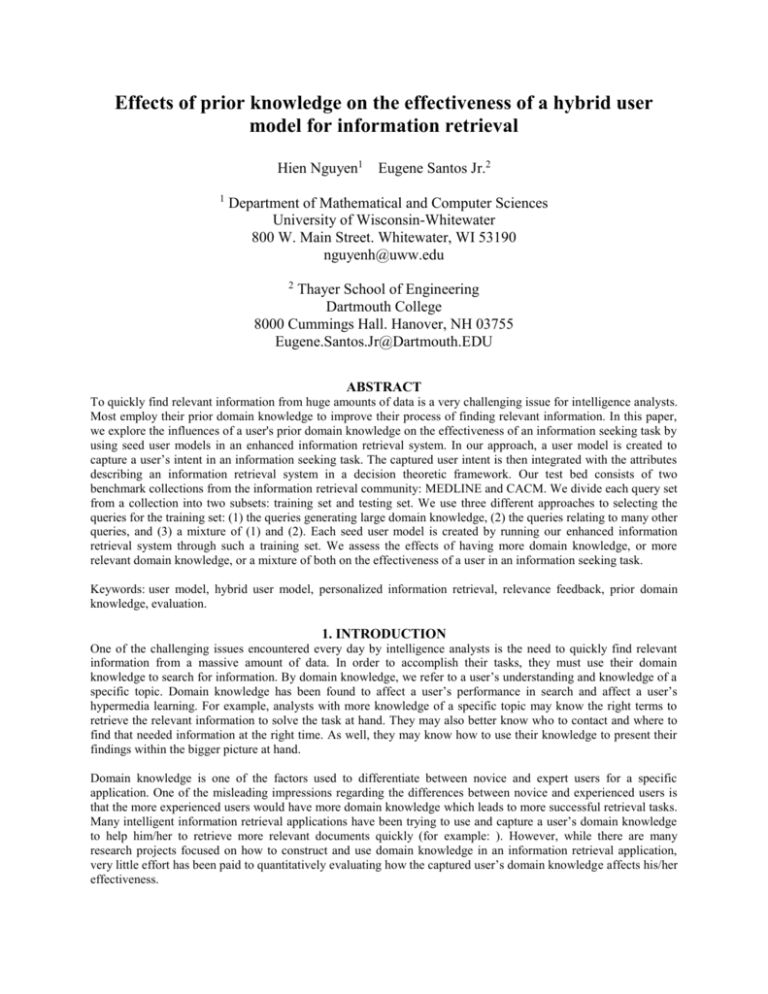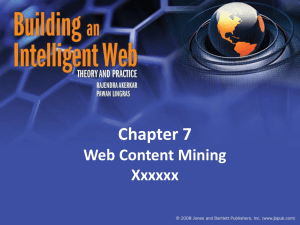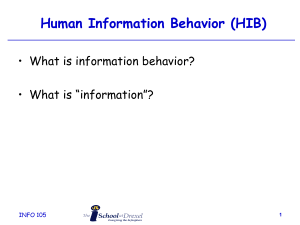practice_paper
advertisement

Effects of prior knowledge on the effectiveness of a hybrid user
model for information retrieval
Hien Nguyen1
1
Eugene Santos Jr.2
Department of Mathematical and Computer Sciences
University of Wisconsin-Whitewater
800 W. Main Street. Whitewater, WI 53190
nguyenh@uww.edu
2
Thayer School of Engineering
Dartmouth College
8000 Cummings Hall. Hanover, NH 03755
Eugene.Santos.Jr@Dartmouth.EDU
ABSTRACT
To quickly find relevant information from huge amounts of data is a very challenging issue for intelligence analysts.
Most employ their prior domain knowledge to improve their process of finding relevant information. In this paper,
we explore the influences of a user's prior domain knowledge on the effectiveness of an information seeking task by
using seed user models in an enhanced information retrieval system. In our approach, a user model is created to
capture a user’s intent in an information seeking task. The captured user intent is then integrated with the attributes
describing an information retrieval system in a decision theoretic framework. Our test bed consists of two
benchmark collections from the information retrieval community: MEDLINE and CACM. We divide each query set
from a collection into two subsets: training set and testing set. We use three different approaches to selecting the
queries for the training set: (1) the queries generating large domain knowledge, (2) the queries relating to many other
queries, and (3) a mixture of (1) and (2). Each seed user model is created by running our enhanced information
retrieval system through such a training set. We assess the effects of having more domain knowledge, or more
relevant domain knowledge, or a mixture of both on the effectiveness of a user in an information seeking task.
Keywords: user model, hybrid user model, personalized information retrieval, relevance feedback, prior domain
knowledge, evaluation.
1. INTRODUCTION
One of the challenging issues encountered every day by intelligence analysts is the need to quickly find relevant
information from a massive amount of data. In order to accomplish their tasks, they must use their domain
knowledge to search for information. By domain knowledge, we refer to a user’s understanding and knowledge of a
specific topic. Domain knowledge has been found to affect a user’s performance in search and affect a user’s
hypermedia learning. For example, analysts with more knowledge of a specific topic may know the right terms to
retrieve the relevant information to solve the task at hand. They may also better know who to contact and where to
find that needed information at the right time. As well, they may know how to use their knowledge to present their
findings within the bigger picture at hand.
Domain knowledge is one of the factors used to differentiate between novice and expert users for a specific
application. One of the misleading impressions regarding the differences between novice and experienced users is
that the more experienced users would have more domain knowledge which leads to more successful retrieval tasks.
Many intelligent information retrieval applications have been trying to use and capture a user’s domain knowledge
to help him/her to retrieve more relevant documents quickly (for example: ). However, while there are many
research projects focused on how to construct and use domain knowledge in an information retrieval application,
very little effort has been paid to quantitatively evaluating how the captured user’s domain knowledge affects his/her
effectiveness.
In our approach, a user model is created to capture a user’s intent in an information seeking task. The captured user
intent is then integrated with the attributes describing an information retrieval system through a decision theoretic
framework. One of the key features of our approach is that we capture a user’s domain knowledge dynamically by
analyzing the commonality of the retrieved relevant documents (relevance as indicated by the user). In this paper,
we are interested in addressing an important research question:
“Does more general domain knowledge which is captured by a user model, lead to a more effective
search? If not, what kind of domain knowledge would potentially lead to a more effective search?”
This problem is critical because it helps to shed light on how to effectively capture and use domain knowledge to
improve a user’s effectiveness in an information seeking task. Additionally, it helps in the future design of more
efficient intelligent information retrieval applications. However, it is a challenging problem because it involves two
open research issues: (1) How to dynamically capture a user’s domain knowledge, and (2) how to assess the
knowledge needed for improving the effectiveness of an information retrieval application. Furthermore, there are
currently few or no standard procedures for evaluating a user’s domain knowledge making it even more difficult. In
this paper, we present our study addressing the above research question and an evaluation approach that takes into
account both open issues.
In our evaluation, we use two benchmark collections from the information retrieval community: MEDLINE and
CACM. We divide each query set from a collection into two subsets: training set and testing set. We use three
different approaches to select the queries to form a training set for each collection: (1) the queries that generate a
large domain knowledge, (2) the queries that are related to many other queries in a testbed and (3) a mixture of both
(1) and (2). Each seed user model is created by running our enhanced information retrieval system through such a
training set in order to capture the notion of prior domain knowledge. We assess the effects of having more general
domain knowledge, or more relevant domain knowledge to the tasks at hand, or a mixture of both on the
effectiveness of a user in an information seeking task. We hypothesize that having more relevant domain knowledge
to the task at hand would be crucial to improve the effectiveness of a user’s performance in an information seeking
task. The main reason behind this hypothesis is that larger domain knowledge may not be enough to a successful
retrieval task because if this domain knowledge centered around a broad topic that subsumes the topics of interests
by the users, they may choose to issue the queries by using the terminologies loosely relating to the task. That may
lead to a worse retrieval performance. Therefore, the domain knowledge that closely relates to the task at hand is
crucial to helping users to retrieve more relevant information.
The study presented in this paper evaluates the knowledge captured by a computational model in an enhanced
information retrieval application. We focus on finding the answer or supported evidence to whether having more
domain knowledge leads to more effectiveness in a retrieval task. The challenges of our study include the difficulty
in capturing a user’s real knowledge using a computational model and the lack of instruments to evaluate how useful
it is. The significance of our result is two fold: First, it sheds some lights on the usefulness of the quality and
quantity of captured knowledge. Secondly, it helps in designing an intelligent information retrieval application with
regards to what kind of knowledge we should focus.
This paper is organized as follows: We begin with an overview of related work followed by a presentation of our
hybrid user model. Next, the evaluation procedure and testbed are discussed. Our results are presented and we
conclude with future work.
2. RELATED WORK
In this section, we present existing work that directly or indirectly evaluates the effect of domain knowledge on
information seeking. By direct evaluation, we refer to the studies that assess the effect of a real user’s domain
knowledge on his/her searching behavior or retrieval success. In an indirect evaluation, we assess a user’s domain
knowledge captured by a computational model instead.
In the information retrieval community, domain knowledge affects many stages in an information seeking task from
query formulation to selecting, seeking, and presenting the relevant information. In the query formulation process,
users with more experience in a search domain may know the terminologies that are used frequently in the domain,
which may be helpful in the process of identifying relevant documents more quickly. Terms and their relationships
are used in formulating the right queries and in developing the users’ search tactics to find the relevant concepts of
the queries quickly. In the early 90s, when user models were first used to improve the user’s performance in
information retrieval, Allen1 found that more experienced users tend to expand the search more than novice users.
The total amount of time preparing for the search and the number of queries in a search have been found to be
influenced by the level of domain knowledge7. Studies have shown that users with higher level of domain
knowledge may issue more queries and use more words in their queries to find relevant information, while the
average number of terms used in a query also increased . A study conducted by Wildmuth23 shows that low level of
domain knowledge is associated with less efficient choices for terms being included in a search and thus prevents
users from quickly reaching their final searching goal. All these studies mentioned above directly assess the effect of
a user’s domain knowledge on search.
Even though many studies have found that domain knowledge positively affected the user’s behaviors in an
information seeking task such as by, increasing the number of terms and the number of queries, very few studies
have explored the relationship between the level of domain knowledge and the amount of retrieved relevant
information. Most of the research in this direction from the early 90s to present have unsuccessfully found any cause
and effect relationship or any relationships between the level of domain knowledge and retrieval success.
While many intelligent information retrieval applications have evaluated the effect of a user’s domain knowledge on
retrieval success in general, to the best of our knowledge, there are only a few studies that focus on analyzing what
kind of domain knowledge most affects the user’s effectiveness in an information seeking task (for example: a study
that evaluates the use of knowledge of a search topic or knowledge of a search system12). In this paper, we focus on
the assessment of effects of general domain knowledge and knowledge relates to the task at hand on the retrieval
success.
3. HYBRID USER MODEL
In this section, we provide background on our user modeling approach which is used to improve the effectiveness of
a user engaged in an information seeking task by building a model about him/her that integrates information from
both the user side and system side in a decision theoretic framework. We need user models for information retrieval
applications because the traditional information retrieval framework does not take into account much of the inputs
available from a user except for queries and relevance feedback. We start by describing the process of determining
information about a user and then present how we combine this information with components of an information
retrieval (IR) application in a decision theoretic framework. We focus on the user side first because the information
about a traditional IR application is usually determined while the system is being developed and used.
3.1 User intent
Our goal is to capture user intent in information seeking. In our approach, a user’s intent is partitioned into three
components: Interests, Preferences, and Context. The Interests refers to what users are doing to achieve their goals,
the Preferences captures how the users may go about achieving their goals, and the Context infers why they are
trying to achieve these goals. We capture the Context, the Interests, and the Preferences aspects of a user’s model
with a context network (C), an interest set (I), and a preference network (P).
A context network (C) is a directed acyclic graph (DAG) that consists of concept nodes and relation nodes. Concept
nodes represent concepts in noun phrases. The relation nodes are divided into two categories: “isa” representing
“set-subset” relationships among concepts and “related-to” relations representing the general relations between one
concept to another one. Our Context network is created dynamically by finding a set of sub-graphs in the
intersection of all retrieved relevant documents. Each document is represented as a document graph (DG) which is
similar to the representation of a context network. For each document, we construct its corresponding DG by first
automatically extracting noun phrases (NPs) from natural language text using Link Parser20. We then use three
heuristic rules to construct the concept nodes and relation nodes: noun phrase heuristic, noun-phrase preposition
phrase heuristic, and sentence heuristic. The main idea of these rules is to establish the relationship among noun
phrases by exploiting syntactic structure of a noun-phrase, a preposition phrase, or a sentence. More details on DG
construction can be found in 25.
The Interests are captured in the interest set which consists of current concepts that a user is focusing on and how
much emphasis he/she has placed on them. The interest set is initially determined from the current query, and the set
of common sub-graphs. The Preference network is captured in a Bayesian network 9. There are three kinds of nodes
in this Preference network: pre-condition (Pr), goals(G), and action nodes(A). Each node has two states: true and
false. Precondition nodes represent the requirements to achieve the goal nodes. Goal nodes represent the tools that
are used to modify a user’s query. We currently have the two tools: (i) filter which narrows down a query
semantically, and (ii) expander which “broadens” up a query semantically. The conditional probability table of each
goal node is similar to the truth table for logical AND. Each goal node is associated with only one action node. The
pre-condition nodes in this example consist of interest concepts and current query nodes. These nodes will be set as
evidence (i.e., to true) if they belong to the current interest set or are fully/partially matched with the current query.
The filter or expander nodes simply mean that the action node associating with them will contain a link to a query
sub-graph that is narrower or broader than the original query sub-graph. A query graph is similar to the document
graph but it is generated from a user’s keyword/text query instead of a full text document. The Preference network is
updated when a user gives feedback. Basically, we add to the current Preference network the tool that helps most in
the previous retrieval processes. If the total number of retrieved relevant documents exceeds a user-defined
threshold, a tool is considered helpful. For more information, please see.
In essence, Context network contains information used to modify a query’s graph while Interest set and Preference
network contain information used to determine how we modify the query graph. The process of modifying a user’s
query graph is shown as follows:
Step 1: We are given a user model M={I, P, C} and a query graph (QG) q.
Step 2: We set as evidence all interest concepts found in P. We find all pre-condition nodes (Pr) representing a
query in P which has associated query graph (QG) that completely or partially matches against the given q. If
such a node is found, it is set as evidence.
Step 3: Belief updating on P is performed. We choose the top n goal nodes from P with highest probability
values (G).
For every goal node g in G:
If the query has been previously submitted and the user has used this goal, the original query sub-graph is
replaced by the graph associated with the action node of this goal.
If the query has not been asked before and g represents a filter: For every concept node qi in the user's
query graph q, we search for its corresponding node cqi in C. For every concept ai in I, we search for its
corresponding node cai in C such that cai is an ancestor of cqi. If such ci and cqi are found, we add the paths
from C between these two nodes to the modified query graph. It works similarly with an expander except
that cai should be a progeny of cqi.
Step 4: The modified QG (q) is sent to the search module where it is matched against each DG representing a
record in our database. Those records that have the number of matches greater than a user-defined threshold are
chosen and displayed to a user. A match between a QG and a DG is defined as
sim (q, d )
n
m
2* N 2*M
where n, m are the number of concepts and relation nodes of q found in d respectively. N, M are the total
number of concept and relation nodes of q. Two relation nodes are matched if and only if at least one of their
parents and one of their children are matched. For more details about our approach, please see our earlier
papers.





